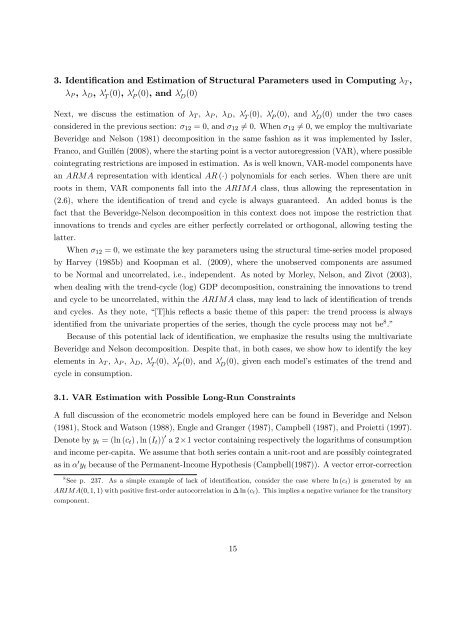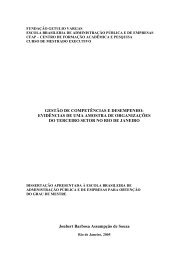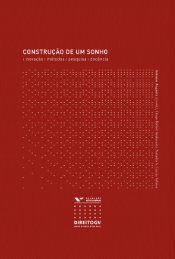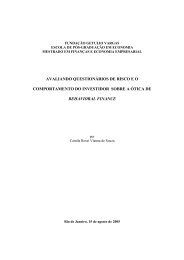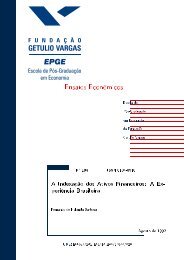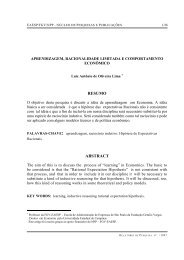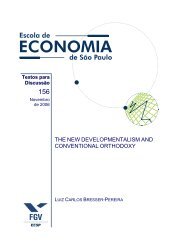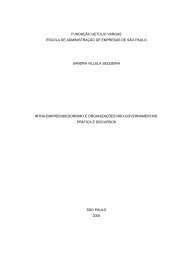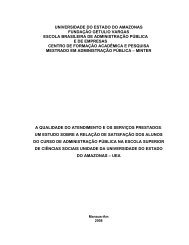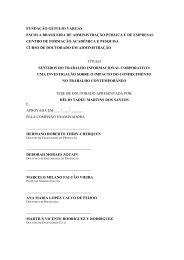Ensaios Econômicos - Sistema de Bibliotecas da FGV - Fundação ...
Ensaios Econômicos - Sistema de Bibliotecas da FGV - Fundação ...
Ensaios Econômicos - Sistema de Bibliotecas da FGV - Fundação ...
You also want an ePaper? Increase the reach of your titles
YUMPU automatically turns print PDFs into web optimized ePapers that Google loves.
3. I<strong>de</strong>nti…cation and Estimation of Structural Parameters used in Computing T ,<br />
P , D , 0 T (0), 0 P (0), and 0 D (0)<br />
Next, we discuss the estimation of T , P , D , 0 T (0), 0 P (0), and 0 D<br />
(0) un<strong>de</strong>r the two cases<br />
consi<strong>de</strong>red in the previous section: 12 = 0, and 12 6= 0. When 12 6= 0, we employ the multivariate<br />
Beveridge and Nelson (1981) <strong>de</strong>composition in the same fashion as it was implemented by Issler,<br />
Franco, and Guillén (2008), where the starting point is a vector autoregression (VAR), where possible<br />
cointegrating restrictions are imposed in estimation. As is well known, VAR-mo<strong>de</strong>l components have<br />
an ARMA representation with i<strong>de</strong>ntical AR () polynomials for each series. When there are unit<br />
roots in them, VAR components fall into the ARIMA class, thus allowing the representation in<br />
(2.6), where the i<strong>de</strong>nti…cation of trend and cycle is always guaranteed. An ad<strong>de</strong>d bonus is the<br />
fact that the Beveridge-Nelson <strong>de</strong>composition in this context does not impose the restriction that<br />
innovations to trends and cycles are either perfectly correlated or orthogonal, allowing testing the<br />
latter.<br />
When 12 = 0, we estimate the key parameters using the structural time-series mo<strong>de</strong>l proposed<br />
by Harvey (1985b) and Koopman et al. (2009), where the unobserved components are assumed<br />
to be Normal and uncorrelated, i.e., in<strong>de</strong>pen<strong>de</strong>nt. As noted by Morley, Nelson, and Zivot (2003),<br />
when <strong>de</strong>aling with the trend-cycle (log) GDP <strong>de</strong>composition, constraining the innovations to trend<br />
and cycle to be uncorrelated, within the ARIMA class, may lead to lack of i<strong>de</strong>nti…cation of trends<br />
and cycles. As they note, “[T]his re‡ects a basic theme of this paper: the trend process is always<br />
i<strong>de</strong>nti…ed from the univariate properties of the series, though the cycle process may not be 8 .”<br />
Because of this potential lack of i<strong>de</strong>nti…cation, we emphasize the results using the multivariate<br />
Beveridge and Nelson <strong>de</strong>composition. Despite that, in both cases, we show how to i<strong>de</strong>ntify the key<br />
elements in T , P , D , 0 T (0), 0 P (0), and 0 D<br />
(0), given each mo<strong>de</strong>l’s estimates of the trend and<br />
cycle in consumption.<br />
3.1. VAR Estimation with Possible Long-Run Constraints<br />
A full discussion of the econometric mo<strong>de</strong>ls employed here can be found in Beveridge and Nelson<br />
(1981), Stock and Watson (1988), Engle and Granger (1987), Campbell (1987), and Proietti (1997).<br />
Denote by y t = (ln (c t ) ; ln (I t )) 0 a 21 vector containing respectively the logarithms of consumption<br />
and income per-capita. We assume that both series contain a unit-root and are possibly cointegrated<br />
as in 0 y t because of the Permanent-Income Hypothesis (Campbell(1987)). A vector error-correction<br />
8 See p. 237. As a simple example of lack of i<strong>de</strong>nti…cation, consi<strong>de</strong>r the case where ln (c t) is generated by an<br />
ARIMA(0; 1; 1) with positive …rst-or<strong>de</strong>r autocorrelation in ln (c t). This implies a negative variance for the transitory<br />
component.<br />
15


